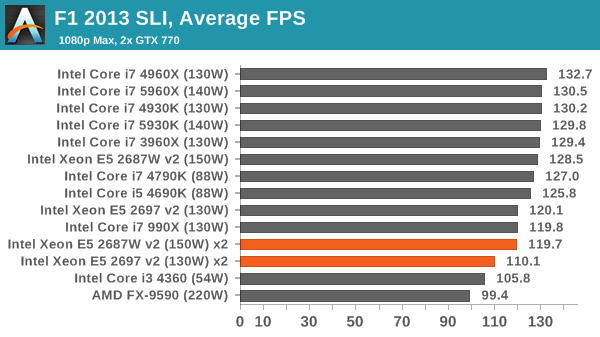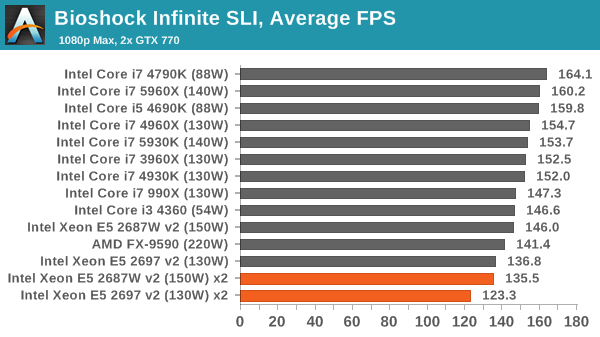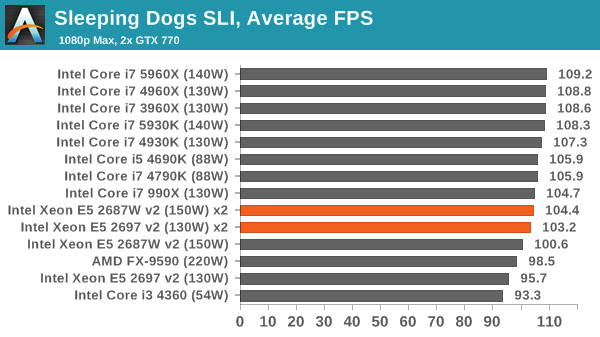GIGABYTE Server GA-7PESH3 Motherboard Review
by Ian Cutress on September 4, 2014 2:00 PM EST- Posted in
- Motherboards
- Intel
- Gigabyte
- Xeon
- Workstation
- Enterprise
- C602
Gaming Benchmarks
While gaming is not a focus of motherboards like the GIGABYTE GA-7PESH3, the system may be in use by content developers relying on an accurate representation with what they are making. GIGABYTE also includes a variety of multiple GPU connectors in the box, indicating that gaming is a use for this system. Gaming on 2P systems is usually restricted by the low single core speed of the processors used, or the memory mismanagement as games are not written to take advantage of a NUMA topology. In fact, our usual Tomb Raider benchmark failed to start at all, suggesting that a 2P system might be wholly engine dependent on what actually works or not. Games that are often heralded as using multiple cores are also usually stumped due to the dual processor nature of the system, causing cross CPU connections to add in extra latency and delays for data.
F1 2013
First up is F1 2013 by Codemasters. I am a big Formula 1 fan in my spare time, and nothing makes me happier than carving up the field in a Caterham, waving to the Red Bulls as I drive by (because I play on easy and take shortcuts). F1 2013 uses the EGO Engine, and like other Codemasters games ends up being very playable on old hardware quite easily. In order to beef up the benchmark a bit, we devised the following scenario for the benchmark mode: one lap of Spa-Francorchamps in the heavy wet, the benchmark follows Jenson Button in the McLaren who starts on the grid in 22nd place, with the field made up of 11 Williams cars, 5 Marussia and 5 Caterham in that order. This puts emphasis on the CPU to handle the AI in the wet, and allows for a good amount of overtaking during the automated benchmark. We test at 1920x1080 on Ultra graphical settings.

F1 2013 typically loves cores and frequency, however there is little gain here over an i3 except for 10-16 FPS in single GPU average frame rates.
Bioshock Infinite
Bioshock Infinite was Zero Punctuation’s Game of the Year for 2013, uses the Unreal Engine 3, and is designed to scale with both cores and graphical prowess. We test the benchmark using the Adrenaline benchmark tool and the Xtreme (1920x1080, Maximum) performance setting, noting down the average frame rates and the minimum frame rates.

Similarly Bioshock Infinite sees the 2P system at the bottom of the pack, especially in minimum frame rates.
Sleeping Dogs
Sleeping Dogs is a benchmarking wet dream – a highly complex benchmark that can bring the toughest setup and high resolutions down into single figures. Having an extreme SSAO setting can do that, but at the right settings Sleeping Dogs is highly playable and enjoyable. We run the basic benchmark program laid out in the Adrenaline benchmark tool, and the Xtreme (1920x1080, Maximum) performance setting, noting down the average frame rates and the minimum frame rates.

The only benchmark where the 2P shines is Sleeping Dogs in minimum frame rates under SLI. Here there is a distinct advantage of having dual processors over a single processor, moving well above 60 FPS minimum. However, the cost for those extra frames makes any other processor seem more palatable.
Battlefield 4
The EA/DICE series that has taken countless hours of my life away is back for another iteration, using the Frostbite 3 engine. AMD is also piling its resources into BF4 with the new Mantle API for developers, designed to cut the time required for the CPU to dispatch commands to the graphical sub-system. For our test we use the in-game benchmarking tools and record the frame time for the first ~70 seconds of the Tashgar single player mission, which is an on-rails generation of and rendering of objects and textures. We test at 1920x1080 at Ultra settings.

Finalising why gaming isn't great on a 2P machine: for Battlefield 4 the i3 scores similar or better than our 2P arrangement.
The end result of the story is: you can game on a dual processor workstation, but it won't be the best experience you can get.














35 Comments
View All Comments
ShieTar - Friday, September 5, 2014 - link
Well, there is a tiny group of people who will be interested: They need a Workstation because they independently work with their PC to create content, but if possible they would also like to use the existing setup to game occasionally, instead of spend another 1k$ and put another Case next to their desk.Also, 10 years ago a lot of Trolls were posting "Yeah but can it run Quake" in the comment section of server hardware reviews. This kind of testing shuts them up.
xxsk8er101xx - Saturday, September 6, 2014 - link
Because the motherboard is designed for the prosumer market. Not the professional/server market. The point of the article is to basically say that this motherboard servers no purpose. It can't be used for the professional/server market because there are too few RAM slots and no mini-sas slots which the majority of the professional market has a need for.Kevin G - Sunday, September 7, 2014 - link
I think this motherboard has priced itself out of the prosumer market a bit at $650 USD and then you have Xeon prices on top of that. I do see this system being a decent pick for some professional tasks though. RAM capacity is still pretty decent as this board accepts 32 GB DIMMs for 256 GB capacity. That's a bit expensive due to 32 GB DIMM pricing but I see 128 GB via 16 GB DIMMs as reasonably priced for what you get. Needing more than 128 GB is a very small niche and one that overlaps widely with the idea of just using servers to batch process the large data sets anyway.The PCIe setup does scream professional though. Components like capture cards and PCIe SSDs are not going to be restricted in performance. (Though it is worrisome that this board doesn't have a dedicated aux power for just the PCIe slots.) The presence of onboard audio also indicates that this certainly isn't a server board.
I have yet to encounter a good reason for SAS in the professional space. 6 Gbit SATA provides enough bandwidth and SSD's can saturate that. SATA hard drives are adequate for bulk storage locally. (There is definitely a niche for SAS in server space with multi path IO for redundancy.) I can see a need for RAID5/6 in the prosumer and professional space but SAS isn't a requirement for it (though incidentally most RAID5/6 cards are SAS based). Even then, in most cases software RAID1 is 'good enough' for redundancy to prevent downtime in the professional space.
AnnihilatorX - Sunday, September 7, 2014 - link
Kindly read the article!: "While gaming is not a focus of motherboards like the GIGABYTE GA-7PESH3, the system may be in use by content developers relying on an accurate representation with what they are making. "gchernis - Thursday, September 4, 2014 - link
Nice write-up! Do you have any data on total CPU utilization with multithreaded tasks? What about kernel-time vs. user mode time split?JellyRoll - Thursday, September 4, 2014 - link
"Server motherboards historically have done rather poor in this test,"....perhaps because it is a server motherboard? are you testing a server workload on it?Samus - Thursday, September 4, 2014 - link
Anand used to do SQL benchmarks. This is what we need for this review to be complete.mavere - Thursday, September 4, 2014 - link
The Handbrake results are a bit disappointing because data-dependency breakpoints occur both naturally (at scene boundaries) and manually (at regular ~10s key-frame intervals). Conceptually, the transcoder can easily reuse the source's chapter-timing metadata and keyframes to outsource chunks of work to each socket with minimal communication overhead.I'm guessing that NUMA performance was never a pressing concern for any of Handbrake's and x264's contributors.
JDG1980 - Thursday, September 4, 2014 - link
I just can't see a good reason to buy into Ivy Bridge at this time, when Haswell-EP is just around the corner. Personally, I'm seriously considering the E5-1650 v3, assuming it comes in at a similar price point to its predecessor (and assuming that there are some decent workstation boards with ECC support available).And it's especially hard for AnandTech to justify the time reviewing this soon-to-be-obsolescent board when they still haven't gotten around to Tonga. I know it's not the most groundbreaking new GPU design (and AMD picked about the worst place in their lineup they possibly could to slot it), but still, it's a new GPU and we haven't seen a review despite every other major site doing so 2 days ago. What's going on with this?
ruthan - Thursday, September 4, 2014 - link
I would buy such machine for gaming if there would be performance benefit, so its good to know and mainstream everytime rules.. Its like SPARC or Power architecture, they cant compete because of mainstream x86 market is huge so, research revenue there are also huge, users requirements are bigger, more universal. This Sparc, Ithanium or Power market exist only because of stupid company policies, like everything from one company, support only for this HW, lies about super duper optimalisation for such HW, and especially license per CPU socket (here realy doesnt matter about price of CPU because, SW licence per socket is astronomical, so you are forced to buy Sparc or Power machine..).